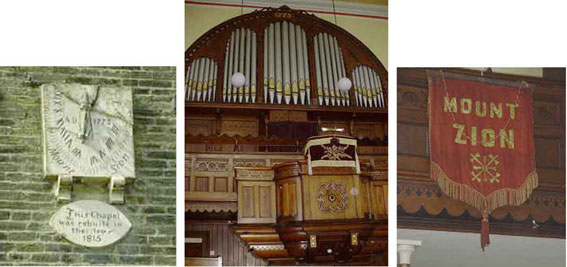A History of Mount Zion History

Mount Zion Chapel South Section c2000
John Wesley came to Halifax to preach on the 22nd August 1748 and in the crowd was a man from Bradshaw, near Halifax, James Riley. He later stated that 'Wesley disturbed my conscience and troubled my soul.' The following Sunday Riley went to Haworth to hear the Rev William Grimshaw (who conducted worship at what is now the Bronte Parsonage Museum.)
This resulted in a regular house meetings being instigated, in and around Brockholes and Ogden, which attracted people like John Nelson of Birstall, who had returned to his home in the north in 1741 after hearing Wesley preach. The aim of building a meeting place for Methodists in the area, may be traced back to 1772 when, during a particularly severe snowstorm, a visiting preacher was stranded for a week at a house of one of the members of the Methodist society.

Mount Zion Chapel and Grounds c2000
As a result, a chapel with an adjoining sexton’s cottage was built. It opened its doors for worship in 1773. It was known as Mount Zion, Bradshaw, as it was situated in the Anglican Parish of Bradshaw. John Wesley visited and stayed in the cottage on the 22nd of April 1774. He recorded in his journal: 'I rode to Bradshaw House, standing alone in a dreary waste. But, although it was a cold and stormy day, the people flocked from all quarters.' He noted that ‘the house afforded hospitality and shelter for man and beast’.
'Told by the Dial' was a small book written by the Reverend Walker, it told the story of the happenings at Mount Zion as if the sundial (which was on the original building) could talk. He mentions the diamond shaped windows in the cottage on which were etched, initials, texts etc. One read 'Time how short - eternity how long. C.W.' Perhaps an indication that Charles Wesley (John’s brother) had visited the Chapel. In May 1790, John Wesley paid his very last visit to Halifax and Mount Zion. He was then a frail 87 years old and we are told that two friends assisted him when he preached and his memory failed.
After Wesley died there was growing disagreement among those in the Methodist Church and this led to different groups forming. In 1797 a small group left the Wesleyan Methodists. They became as the New Connexion and were led by Alexander Kilham. At Mount Zion the Kilhamites dominated, they ousted the Wesleyans who were forced to worship in a barn across the road. Consequently, Mount Zion is recognised as the oldest Methodist New Connexion society, one which constantly met well into the 21st century.

The Mount Zion Sundial (left), Pulpit and Anneessens Organ (centre), Mount Zion Tapestry (right)
In 1773 the original chapel was demolished. The present building opened its doors in 1815. All that remains of the 1773 building are the sundial on the front of the building and the foundation stone. An impression of the original chapel may be gained from the adjoining chapel keeper's cottage which was erected at the same time as the first chapel and in the same architectural style.
The organ in the present building originates from 1892. It was made by Charles Anneessens et fils, Grommont, Belgique. It is believed that there probably about six of this type of organ have survived and are still in working order. The original blower remains visible, but the organ now has an additional electric blower. There exist records of the son of the maker visiting Mount Zion during World War 1 and his grandson in July 1969.
The interior of the Chapel was designed by company called by Leeming and Leeming in 1881. This firm of architects became very well-known and designed the interior of some very grand buildings, including that of the Admiralty Building in London. The pews were crafted from pitch pine and worshippers paid ‘a pew rent’ to secure their seat. There are 170 ground floor and 180 gallery places. The original pew rent board may still be viewed in the Chapel.
Mount Zion has a long history of providing education for local children on a Sunday. The Chapel has been associated with several Sunday School buildings, the first was built in 1816. On its ground floor it boasted a day school (prior to the 1870 Education Act) for local children. The upper floor was used for ‘Sunday schooling’. The last Mount Zion Sunday school building still exists, but it is now a dwelling in private ownership. |